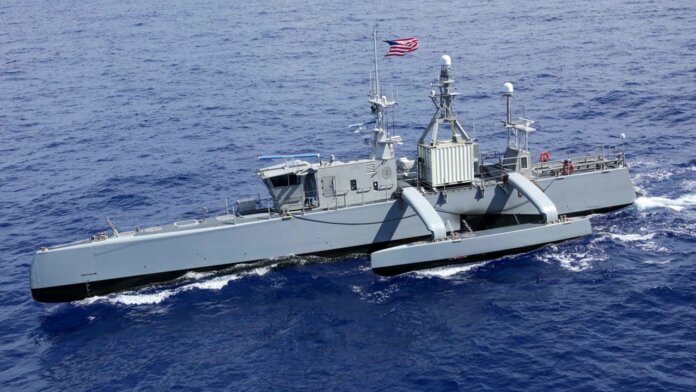The U.S. Navy plans to stand up its second unmanned surface drone squadron this May, two years after the U.S. Pacific Fleet (CNSP) formed the Unmanned Surface Vessel Division (USVDIV). The news was revealed by Admiral Samuel Paparo, commander of the U.S. Pacific Fleet at the West 2024 conference in San Diego last week.
The past two years has seen the U.S. Navy significantly step-up efforts to adopt USVs and integrate their use into manned-unmanned teaming operations. USVDIV One overseas the Sea Hunter and Sea Hawk, both 132 ft (40m) autonomous USVs that first entered service in 2016, under the the DARPA Anti-Submarine Warfare Continuous Trail Unmanned Vessel (ACTUV) programme. It also now operates the USV Nomad and USV Mariner, two 193 ft (59m) ‘medium unmanned service vessels’ that were launched in 2022 as part of the DOD’s Ghost Fleet Overlord program.
All the four vessels can be operated autonomously, or controlled by the U.S. Navy’s Unmanned Operations Center in Port Hueneme, California, or from a nearby U.S. Navy ship. The USVs are not designed to accommodate people, although the Sea Hunter and Sea Hawk have a bridge for piloting the USVs when entering or leaving a port.
USVDIV One has undertaken extensive exercises over the past two years and a five-month deployment in the Pacific Ocean, where the four USVs sailed a combined distance of 46,651 nautical miles and visited ports in Japan and Australia. The USVs were used to test concepts for integrating manned and unmanned fleet operations. During the deployment the USVs operated almost entirely autonomously for weeks at a time
The new squadron is expected to include smaller USVs than USVDIV One. Like the first, USVDIV Two is expected to continue to build the foundational knowledge required to fully integrate USVs into U.S. Navy fleets. The role of smaller these USVs could take in Intelligence, surveillance, target acquisition, and reconnaissance, through to offensive capabilities. The Navy envisions a future where there are numerous USVs in any theatre of operations, with or without manned vessels.
The U.S. Navy is currently in the early stages of developing an Integrated Combat System, together with contractor Lockheed Martin, which will eventually connect the operations of manned and key unmanned vessels, allowing for more seamless combined operations. Until then there is a lot more practical experience that the Navy needs to gain on how manned and unmanned assets can work together. The standing up of USVDIV Two is another key step to accelerate that process.
by Carrington Malin













